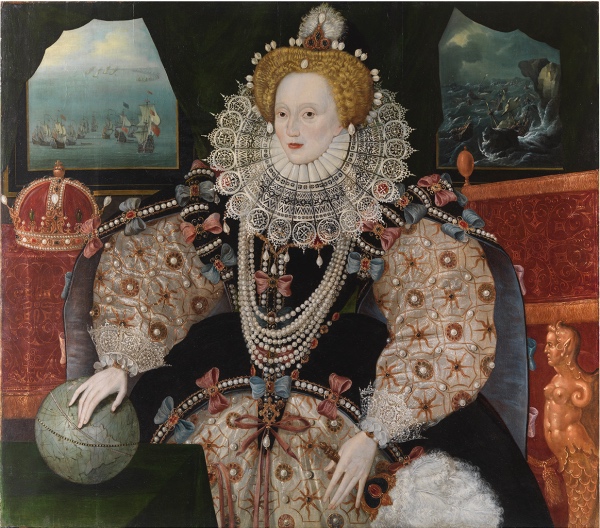Saved for the nation following a public appeal by the Art Fund and Royal Museums Greenwich in 2016 and subsequently having undergone an extensive conservation and restoration process, the ‘Armada Portrait of Elizabeth I’ now hangs in the 400-year-old Inigo Jones-designed Queen’s House in Greenwich.
The life-sized portrait, which is unusually presented in a landscape format, commemorates the failed invasion of England by the Spanish Armada in the summer of 1588. It was painted in about 1590 by an unknown artist when the queen was aged in her mid-50s and may have been commissioned by Sir Francis Drake, second-in-command of the English fleet assembled to defend England from the Spanish.
Up until its £10.3 million acquisition (which was funded by various donations including a £1 million donation from the Art Fund, £400,000 from the Royal Museums of Greenwich, some 8,000 individual donations from members of the public totalling £1.5 million, and a Heritage Lottery Find grant of £7.4 million), it had been owned by Drake’s descendants – now known as the Tyrwhitt-Drakes – who have had possession since at least 1775. It spent much of its life hanging at Shardeloes, a Buckinghamshire country house built for William Drake in the late 18th century.
Designed to inspire a sense of awe in its viewers, the portrait contains numerous references which would have conveyed specific meanings to the Tudor mind. The Queen’s upright posture, open arms and clear gaze, for example, convey vitality and strength while her pearls are symbols or chastity and the Moon. The gold suns embroidered on her skirt and sleeves are said to symbolise power and enlightenment and the queen rests her hands on a globe with her fingers seeming tapping on the new world with the imperial crown sitting overhead in fairly obvious statement of her ambitions overseas.
Two maritime scenes in the background, both of which are actually early 18th century reworking over late 16th century originals, depict firstly the English fleet preparing to engage the Spanish Armada in the English Channel and, secondly, Spanish ships being wrecked on the Irish coast during their passage home.
One of the best known images from English history, the portrait has inspired countless portrayals of Elizabeth on stage and screen, including Cate Blanchett’s in two ‘Elizabeth’ films.
The Queen’s House, where the painting is being displayed, is built on the site of what was once Greenwich Palace, birthplace of Queen Elizabeth I.
WHERE: Queen’s House, Romney Road, Greenwich (nearest overground station is Greenwich/DLR is Cutty Sark for Maritime Greenwich); WHEN: 10am to 5pm daily; COST: free; WEBSITE: www.rmg.co.uk/queens-house.
PICTURE: © National Maritime Museum, London



